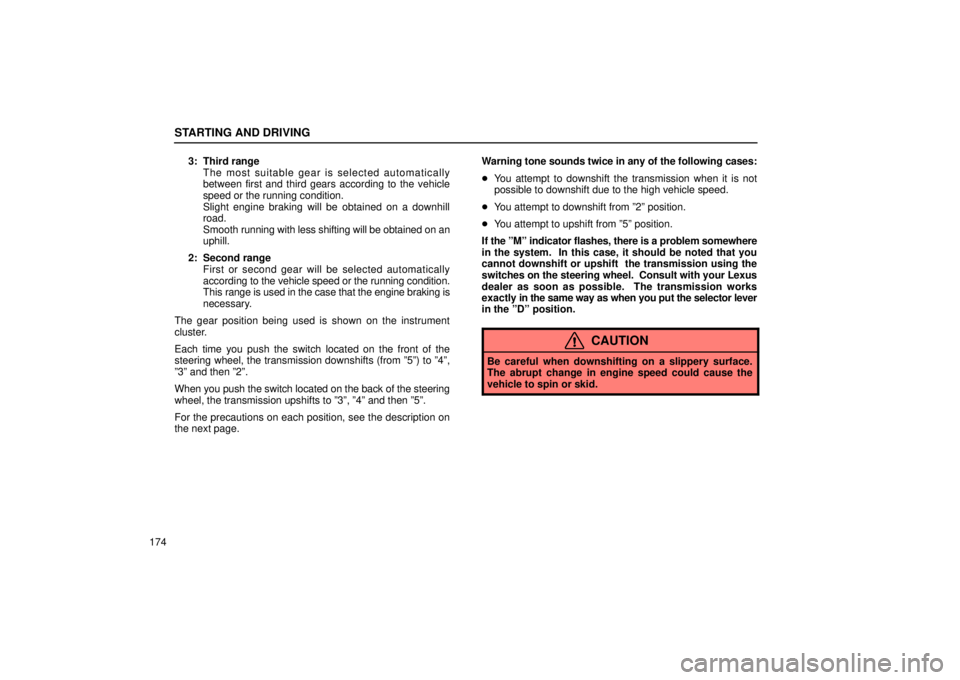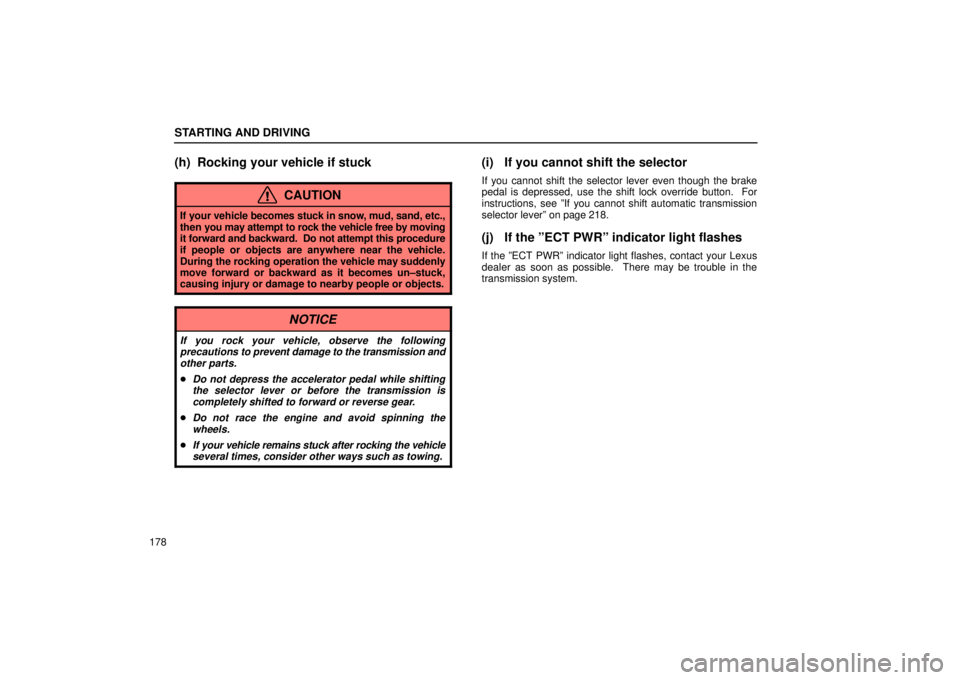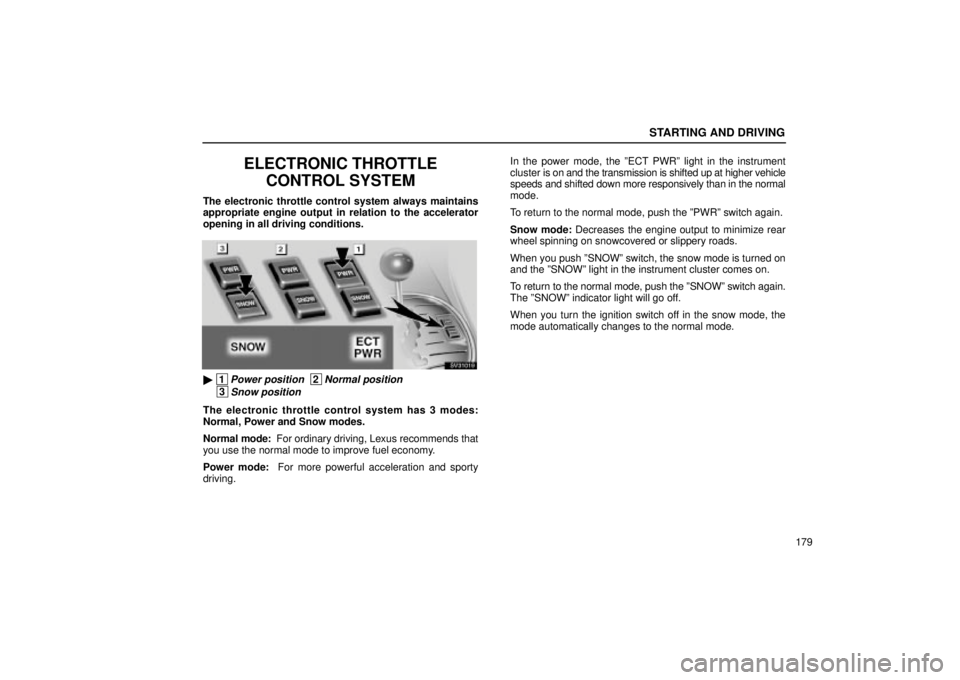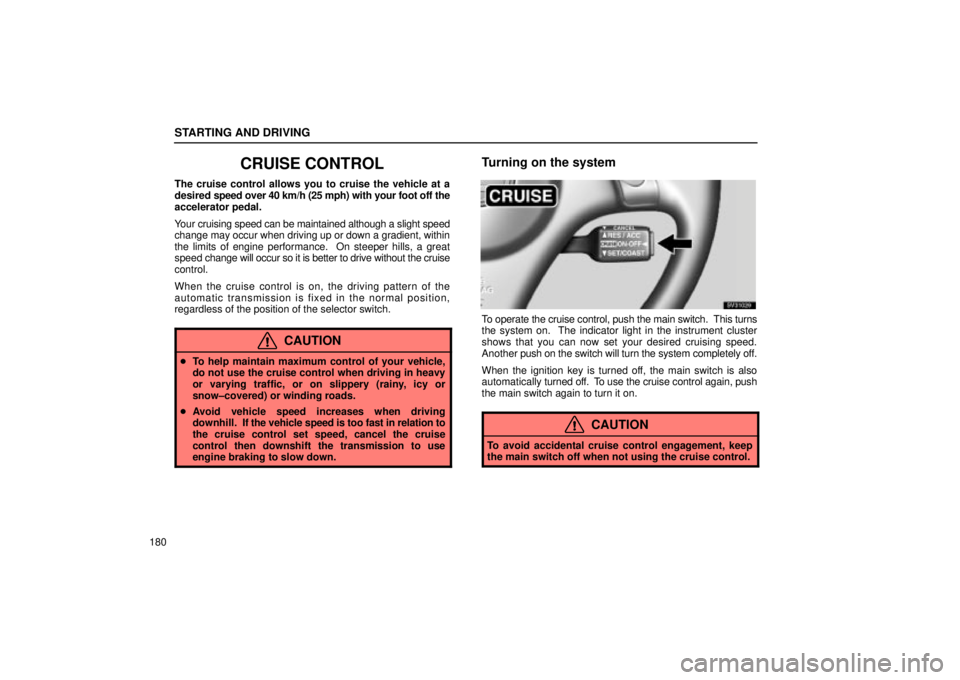Page 182 of 307
STARTING AND DRIVING
169
If the weather is below freezing, let the engine warm up for a
few minutes before driving. Do not leave the vehicle while the
engine is warming up.
If the engine stalls ...
Simply restart it , using the correct procedure given in normal
starting.
If the engine will not start
See ºIf your vehicle will not startº on page 200.
NOTICE
�Do not crank for more than 30 seconds at a time. This
may overheat the starter and wiring systems.
�Do not race a cold engine.
�If the engine becomes difficult to start or stallsfrequently, have the engine checked immediately.
AUTOMATIC TRANSMISSION
Your automatic transmission has a shift lock system to
minimize the possibility of incorrect operation. This
means you can only shift out of ºPº position when the
brake pedal is depressed with the ignition switch in ºONº
position. (� )
SV31020
Page 183 of 307
STARTING AND DRIVING
170�
The shift position is displayed on the instrument
cluster.
P: Parking, engine starting and key removal position
R: Reverse position
N: Neutral position
D: Normal driving position (Shifting into overdrive
possible)
M: Position for manual shifting up or downshifting
When the cruise control is being used, even if you
downshift from ºDº to ºMº, engine braking will not be
enabled because the cruise control is not cancelled. For
the operation to decrease the vehicle speed, see page
182.
3, 2: Position for more powerful engine braking
L: Position for maximum engine braking Correct use of the automatic transmission is explained in
the following parts.
(a) Normal driving
(b) Driving in M mode
(c) Using engine braking
(d) Using the º3º, º2º and ºLº positions
(e) Backing up
(f) Parking
(g) Good driving practice
(h) Rocking your vehicle if stuck
(i) If you cannot shift the selector lever
(j) If the ºECT PWRº indicator light flashes
Page 185 of 307

STARTING AND DRIVING
172
SV31022
� 1Brake pedal 2ºDº (Drive) position
4. With your foot holding down the brake pedal, shift the
selector lever to ºDº.
Always use the ºDº position to improve fuel economy and quiet
driving. Only in this position, shifting into the overdrive gear is
possible. However, while the engine coolant temperature is
low, the transmission will not shift into the overdrive gear even
in the ºDº position. (See º(c) Using engine brakingº and\
º(g)
Good driving practiceº for exceptions.)
CAUTION
Never put your foot on the accelerator pedal while
shifting.
5. Release the parking brake and brake pedal. Depress
the accelerator pedal slowly for smooth starting.
In normal cruising, the vehicle will start in the first gear and
automatically shift up to the most suitable gear. On inclines,
declines or winding r oads, etc., the vehicle shifts up and down
automatically according to the running conditions to obtain the
suitable driving power and engine braking.
When the lever is in º3º position, the automatic transmission
system will select the most suitable gear for the running
conditions such as hill climbing, hard towing, etc.
If you need to accelerate rapidly while driving, depress the
accelerator pedal to the full throttle position. This provides
more acceleration by automatically downshifting the
transmission to the next lower gear or beyond, depending on
the vehicle speed.
If engine braking is needed, such as in descending a long hill,
see º(b) Using engine brakingº.
Page 187 of 307

STARTING AND DRIVING
1743: Third range
The most suitable gear is selected automatically
between first and third gears according to the vehicle
speed or the running condition.
Slight engine braking will be obtained on a downhill
road.
Smooth running with less shifting will be obtained on an
uphill.
2: Second range First or second gear will be selected automatically
according to the vehicle speed or the running condition.
This range is used in the case that the engine braking is
necessary.
The gear position being used is shown on the instrument
cluster.
Each time you push the switch located on the front of the
steering wheel, the transmission downshifts (from º5º) to º4º\
,
º3º and then º2º.
When you push the switch located on the back of the steering
wheel, the transmission upshifts to º3º, º4º and then º5º\
.
For the precautions on each position, see the description on
the next page. Warning tone sounds twice in any of the following cases:
�
You attempt to downshift the transmission when it is not
possible to downshift due to the high vehicle speed.
� You attempt to downshift from º2º position.
� You attempt to upshift from º5º position.
If the ºMº indicator flashes, there is a problem somewhere
in the system. In this case, it should be noted that you
cannot downshift or upshift the transmission using the
switches on the steering wheel. Consult with your Lexus
dealer as soon as possible. The transmission works
exactly in the same way as when you put the selector lever
in the ºDº position.
CAUTION
Be careful when downshifting on a slippery surface.
The abrupt change in engine speed could cause the
vehicle to spin or skid.
Page 189 of 307

STARTING AND DRIVING
176
(d) Using the º3º, º2º and ºLº positions
The º3º, º2º and ºLº positions are used for strong engine
braking as described previously.
With the selector lever in º3º, º2º or ºLº, you can start t\
he vehicle
in motion as with the lever in ºDº.
With the selector lever in º3º or º2º, the vehicle will star\
t in first
gear and automatically shift to the third or second gear.
With the selector lever in ºLº, the transmission is engaged in
the first gear.
NOTICE
�Be careful not to over±rev the engine. Watch the tachometer to keep engine rpm from going into thered zone. The approximate maximum allowablespeed for each position is given below for yourreference:
º3º 124 km/h (78 mph)
. . . . . . . . . . . . . . . . . . .
º2º 81 km/h (51 mph)
. . . . . . . . . . . . . . . . . . .
ºLº 52 km/h (33 mph)
. . . . . . . . . . . . . . . . . . .
�Do not continue hill climbing or hard towing for a long
time in the º3º, º2º or ºLº position. This may causesevere automatic transmission damage from
overheating. To prevent such damage, º4º positionshould be used in hill climbing or hard towing.
(e) Backing up
SV31025
� 1Brake pedal 2ºRº (Reverse) position
1. Bring the vehicle to a complete stop.
2. With the brake pedal held down with your foot, shift the
selector lever to the ºRº position.
NOTICE
Never shift into reverse while the vehicle is moving.
Page 191 of 307

STARTING AND DRIVING
178
(h) Rocking your vehicle if stuck
CAUTION
If your vehicle becomes stuck in snow, mud, sand, etc.,
then you may attempt to rock the vehicle free by moving
it forward and backward. Do not attempt this procedure
if people or objects are anywhere near the vehicle.
During the rocking operation the vehicle may suddenly
move forward or backward as it becomes un±stuck,
causing injury or damage to nearby people or objects.
NOTICE
If you rock your vehicle, observe the following precautions to prevent damage to the transmission and
other parts.
�Do not depress the accelerator pedal while shifting the selector lever or before the transmission iscompletely shifted to forward or reverse gear.
�Do not race the engine and avoid spinning thewheels.
�If your vehicle remains stuck after rocking the vehicleseveral times, consider other ways such as towing.
(i) If you cannot shift the selector
If you cannot shift the selector lever even though the brake
pedal is depressed, use the shift lock override button. For
instructions, see ºIf you cannot shift automatic transmission
selector leverº on page 218.
(j) If the ºECT PWRº indicator light flashes
If the ºECT PWRº indicator light flashes, contact your Lexus
dealer as soon as possible. There may be trouble in the
transmission system.
Page 192 of 307

STARTING AND DRIVING
179
ELECTRONIC THROTTLECONTROL SYSTEM
The electronic throttle control system always maintains
appropriate engine output in relation to the accelerator
opening in all driving conditions.
SV31019
� 1Power position 2Normal position
3Snow position
The electronic throttle control system has 3 modes:
Normal, Power and Snow modes.
Normal mode: For ordinary driving, Lexus recommends that
you use the normal mode to improve fuel economy.
Power mode: For more powerful acceleration and sporty
driving. In the power mode, the ºECT PWRº light in the instrument
cluster is on and the transmission is shifted up at higher vehicle
speeds and shifted down more responsively than in the normal
mode.
To return to the normal mode, push the ºPWRº switch again.
Snow mode: Decreases the engine output to minimize rear
wheel spinning on snowcovered or slippery roads.
When you push ºSNOWº switch, the snow mode is turned on
and the ºSNOWº light in the instrument cluster comes on.
To return to the normal mode, push the ºSNOWº switch again.
The ºSNOWº indicator light will go off.
When you turn the ignition switch off in the snow mode, the
mode automatically changes to the normal mode.
Page 193 of 307

STARTING AND DRIVING
180
CRUISE CONTROL
The cruise control allows you to cruise the vehicle at a
desired speed over 40 km/h (25 mph) with your foot off the
accelerator pedal.
Your cruising speed can be maintained although a slight speed
change may occur when driving up or down a gradient, within
the limits of engine performance. On steeper hills, a great
speed change will occur so it is better to drive without the cruise
control.
When the cruise control is on, the driving pattern of the
automatic transmission is fixed in the normal position,
regardless of the position of the selector switch.
CAUTION
� To help maintain maximum control of your vehicle,
do not use the cruise control when driving in heavy
or varying traffic, or on slippery (rainy, icy or
snow±covered) or winding roads.
� Avoid vehicle speed increases when driving
downhill. If the vehicle speed is too fast in relation to
the cruise control set speed, cancel the cruise
control then downshift the transmission to use
engine braking to slow down.
Turning on the system
SV31029
To operate the cruise control, push the main switch. This turns
the system on. The indicator light in the instrument cluster
shows that you can now set your desired cruising speed.
Another push on the switch will turn the system completely off.
When the ignition key is turned off, the main switch is also
automatically turned off. To use the cruise control again, push
the main switch again to turn it on.
CAUTION
To avoid accidental cruise control engagement, keep
the main switch off when not using the cruise control.